Do you have big aspirations for your ecommerce business?
Good!
We’ve got just the thing for you…
In this guide, I’m going to walk you through a 12-month ecommerce marketing plan you can use to successfully grow your business. Each month contains actionable and tactical strategies that you’ll be able to refer to again and again throughout the year.
The secret to ecommerce success is not just to get your products out there and see how they perform. Without a marketing plan, you might miss out on the fact that 96% of Americans with internet access have made an online purchase in their life, 80% in the past month alone.[*]
Note: Download this calendar so you can follow this guide and plan out your weekly marketing activities for 2019 as you read!
Download Your 12-Month Ecommerce Marketing Plan Calendar
Ready to dive in? Let’s do it!
%(tableofcontents)
Follow this month-by-month ecommerce marketing plan to grow your business in 2019.
January: Rank Top 10 In Search Engines By Mapping Out Your Content With A Focus On SEO
One of the very best ways to drive consistent traffic to your website and increase sales is by creating content that matters.
- Websites with 51 to 100 pages generate 48% more traffic than websites with 1 to 50 pages[*]
- Companies that published 16+ blog posts per month got almost 3.5X more traffic than companies that published 0-4 monthly posts[*]
But much too often businesses create content without knowing exactly how it will perform in terms of traffic, engagement, and sales.
Yikes!
Here’s a quick, easy-to-follow process to ensure that every single piece of content you create will make a difference towards your bottom line.
Step One: Create a list of relevant keywords with mid-to-high (1K+) monthly search volume using a tool like Google Keyword Planner or Moz’s Keyword Research Tool.
Example: “holiday gift ideas”
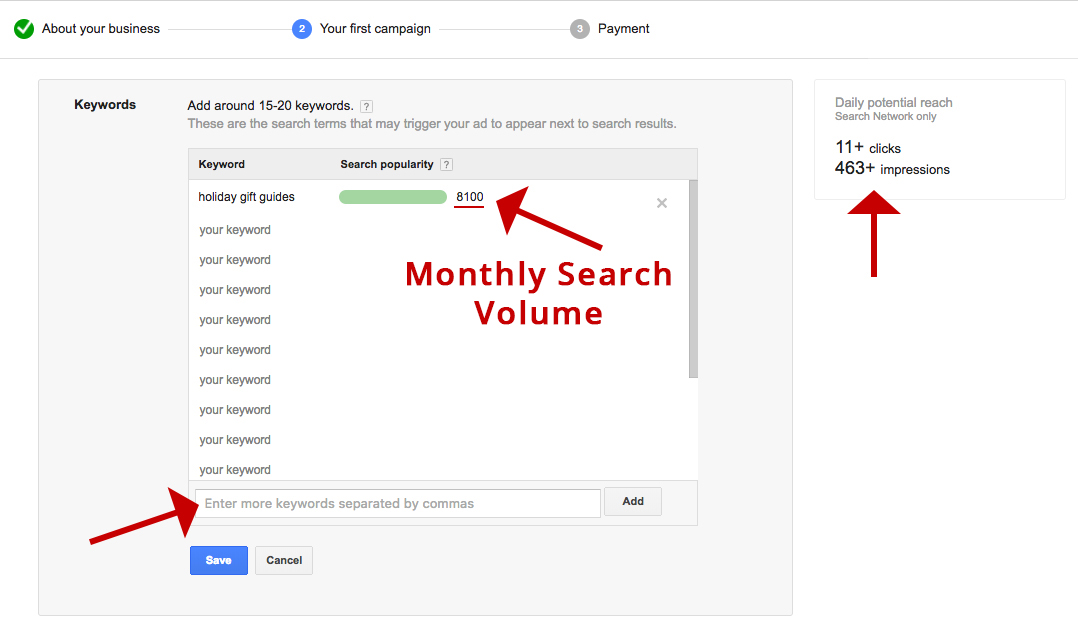
Google Keyword Planner provides specific data about the keyword’s monthly search volume as well as an option to see similar keywords with one click of a button.

Here’s what it looks like after clicking “More Like This”:

Step Two: Brainstorm 5-10 additional keywords for each of the keywords identified in step one. For each keyword with mid-to-high monthly search volume, you should have several similar keywords that you can write content for in addition to the main keyword.
Writing multiple pieces of content around certain keywords or phrases allows Google to rank multiple pages, some of which will perform better than others. It also provides more opportunities for backlinks to your website.
Once you start to see some organic traffic flow into certain blog posts, you’ll want to begin to create additional pieces of content around that “anchor”. For example, if you’re ranking for the phrase “top blenders”, you can then create content like “top kitchen appliances”, or “top gifts for the chef in your life” with natural backlinks to the anchor post.
Step Three: Start writing content (blog posts and product pages) around each of the major keyword opportunities you’ve identified in steps one and two.
The key to finding success with content and SEO as an ecommerce business is consistency. The more content and product pages you create, the better chance you have for your content to rank in search engines.

That means writing product pages with SEO in mind as well; taking the same approach you would with blog posts — natural use of keywords, backlinks from throughout your website and external websites, mobile-friendly, etc.
If you’re stuck how to implement these content ideas, here are 10 types of content you can create that are proven to drive traffic based on an analysis of 175 million pageviews.
February: Use Your "Mafia Offer" To Make Sales On Facebook And Instagram
While there are dozens of advertising channels available to ecommerce businesses, there are only two that can begin to increase revenue from day one: Facebook and Instagram.
Many other channels require a lot of work up front (Influencer Marketing), others can take months to bear fruit (content marketing), while some are difficult to master with a small team (AdWords).
Social media advertising has proven to be the best channel when it comes to ROI:[*]

I could write a book about how to succeed with Facebook and Instagram advertising, but here’s a proven plan to get you up and running right away:
Step One: Identify Your Highest Converting Offer
At the heart of every successful advertising strategy is an offer that can’t be refused. It can be a piece of content, a top-selling product, a promotion, a freebie, or just about anything that you can think of that consistently works.
If you’re not sure where to start, here’s what I would do. First, open up Google Analytics and click Behavior > Site Content > All Pages. This is what it’ll look like:

By default, Google Analytics sorts your most visited web pages by traffic over the last seven days. This is a great place to start when determining which products or content you should consider advertising.
Step Two: Create Your Target Audience
The convenient thing about the two social media giants (Facebook and Instagram) is that you can run all of your advertisements from a single platform — Facebook Ads Manager.[*]
You’ll want to make sure you have the Facebook Pixel set up on all of your web pages so that you can create a variety of high-performing audiences. To do so, go to Facebook Ads Manager > Audiences > Create Audience > Custom Audience > Website Traffic.

Creating a Custom Audience based on your website traffic is a valuable way to get your “offer” in front of targeted customers already familiar with your brand.
Next, create a Lookalike Audience based on your highest value customers.
Lookalike audiences are a cohort of users that “look” most similar to your current audience in terms of demographics, interests, activities, and more. In other words, you’re creating an audience that is most likely to interact with your content.
Click on Create Audience > Custom Audience > Customer File. I highly recommend uploading a list of emails of people that 1) subscribe to your newsletter or belong to your website and 2) people who have made a purchase from your business in the past.
Once you have an email list uploaded, click Create Audience > Lookalike Audience. Then, select the specific Custom Audience that you just created with your email list under Source.

Those are two great audiences to start with. That’ll give you a nice balance of people familiar with your brand and those who aren’t, but are most likely to interact with your ads.
Step Three: Optimize Your Ads for ecommerce Sales
After you have your offer and audiences lined up, it’s time to dive into creating the actual ad.
Videos are the best way to advertise your product. Now that doesn’t mean images don’t work, because they do, but videos (particularly collection ads) have proven to produce incredible advertising results.[*]
It’s this…
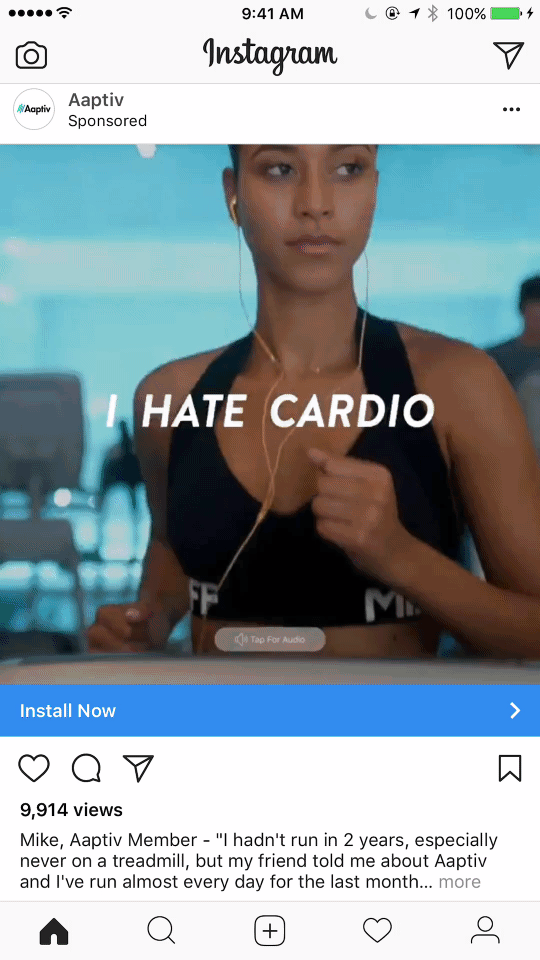
Vs. this…

Both are great, but the video stands out much more in the feed.
Take your highest performing products and or pages, and turn them into quick, 10-30 second videos to use as ads on Facebook and Instagram. You can do this by taking key headlines, descriptions, and images throughout the article and drop them into a video editor like iMovie or Animoto.
Essentially, you’re creating an “article recap” that people can quickly consume on the go without having to read the full post.
Last but not least, here are a few takeaways that will help lead to a lower cost per click (CPC) and higher ROI:
- Use beautiful images without text (don’t distract from the product)
- Boosting a post can be just as powerful as a traditional advertisement
- Interactive creatives such as Canvas Ads, Carousel Ads, and Dynamic Ads will help your products stand out (though they’re much more time-consuming to create)
- Videos are the ultimate advertising creative
- A/B/C/D/E/F/G test until you find the right combination of offer, copy, target audience, video (or image!) and desired results
March: Create An Automated Email Campaign That Turns Casual Subscribers Into Lifelong Customers And Advocates
With all of the hype around content marketing and social media over the last few years, it can be easy to forget how important email is to your ecommerce marketing plan.
This small ecommerce company didn’t forget. They got 390 new sales when they started using email marketing the right way in their first month.
Here’s how to set up three automated email campaigns with some of the most recommended marketing tools to make sales from your email list.
Email One: Welcome Email
A good welcome email hits a person’s inbox as soon as they subscribe to one of your email lists or make a purchase on your website.
Avoid “selling” to new subscribers right away. Use the welcome email as an opportunity to build a relationship with your customer by providing them useful and valuable information.
One of my favorite examples of a welcome email done well is from the men’s outdoor retail brand Huckberry. Instead of sending me a “sales” email as their first point of communication, they send an invitation to Start the Adventure:

Email Two: Abandoned Cart Email
67.23% of online shopping carts are abandoned before the customer completes a sale.[*]
Abandoned carts are the perfect opportunity to send your almost-customers a gentle email reminder that they have an item waiting to be purchased. It might be all they need to finally pull the trigger.
A good abandoned cart email is not pushy or aggressive at all. It includes a reminder of the items they’ve abandoned, good copy, and a beautiful visual of the product(s).
Here’s one of my favorite cart abandon email examples from Chubbies. Notice the catchy email subject line along with the fun copy and imagery that fits with their brand:

Email Three: Upsell Offer Email
Did you know that more than 35% of what consumers purchase on Amazon and 75% of what they watch on Netflix come from product recommendations?[*]
Product upsells and recommendations can help to:
- Increase revenue through repeat or multiple purchases from current customers
- Entice potential customers to make their first purchase
Use these segments when deciding who to send upsell offers to:
- Similar products to customers who have purchased in the past
- New products to potential customers who have never made a purchase
- New products to customers who have purchased in the past
- Special deals, discounts, and promos to all email subscribers
Here’s a great example of an upsell email from Surfline targeted at their Premium subscribers to buy their new holiday gear:

April: Get Your First 10,000 Instagram Followers By Following This Proven Strategy
When I think about ecommerce businesses and social media, I think of Instagram.
50% of Instagrammers follow at least one brand on the platform, and 75% of those Instagrammers will take action on a call to action (such as going to a website) after reading an Instagram post.[*]
There’s a ton of Instagram advice out there on just about everything you can think of, but here are a few ways for your business to stand out on the massive platform:[*]
Step One: Write a Killer Bio
Your Instagram bio is your first (and maybe last) chance to impress potential customers that visit your profile.
It should include everything that makes your company and product awesome in 150 characters or less. Oh, and it should constantly be changing to match current promotions or product releases that you have going on throughout the year.
Here’s what your bio should include:
- 60-90 characters about what makes your business unique
- 30-50 characters about a promotion or new release
- 30-50 characters that include a strong call to action (CTA)
Good As Gold, one of the top ecommerce businesses on Shopify, executes this perfectly with their Instagram bio:
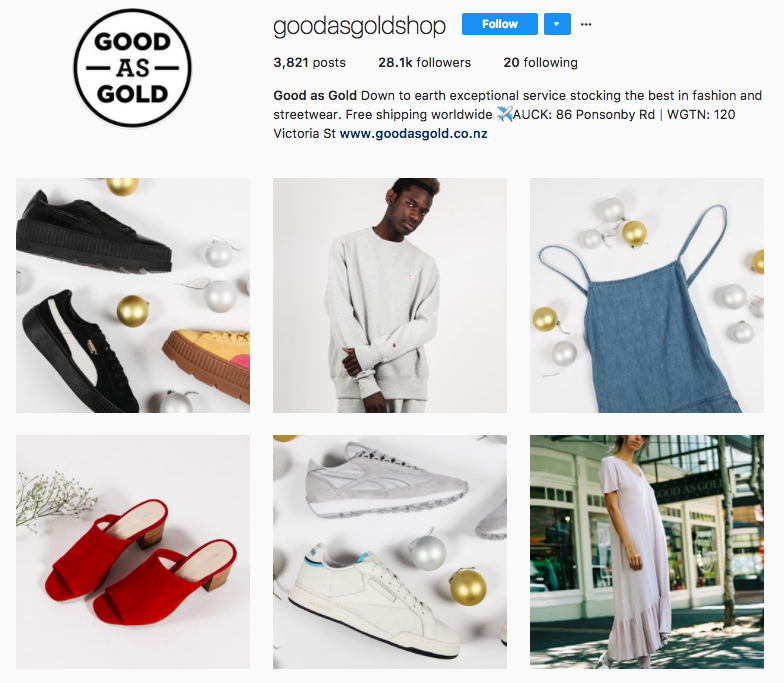
Step Two: Develop a Feed Theme
The second thing potential customers do right after reading your Instagram bio is to look at your feed.
This is your chance to show off your professional creativity. Simply having good photos isn’t always enough to entice people to buy your products.
There are several ways to create a cohesive Instagram feed, but here are a few of my favorites:
- Organize your feed around a consistent theme (travel, outdoors, food, clothing, etc.)
- Use the same filter in every one of your photos to create an artistic effect
- Aim to include the same types of colors in all of your photos to show togetherness
lululemon does an incredible job of creating a beautiful Instagram feed by continually using whites, pinks, purples, oranges, and other similar colors:

Step Three: Utilize Native CTAs
Native CTAs are made to feel like they’re not advertisements at all, which is why they are perfect for Instagram.
If you attempt to sell your product with every post, people will eventually get turned off and might even unfollow your brand on Instagram.
But a perfectly timed, beautiful product photo with a strong CTA can lead to higher clicks and even direct revenue from Instagram. Huckberry has mastered the art of both a beautiful, highly curated Instagram feed and a perfectly timed product CTA.

May: Reach Your Target Customer and Boost Brand Awareness With Influencer Marketing
Influencer marketing isn’t new to ecommerce by any means; it’s been around for years. But that doesn’t mean it isn’t one of the best ways to drive traffic to your website and increase revenue.
According to a study from TapInfluence and Nielsen of one Fortune 500 food brand, influencer marketing can drive annual incremental sales at a rate of 11x versus traditional digital advertising.[*]
In short, influencer marketing is when a brand partners with a well-known internet or social media personality (influencer) to expand the brand’s credibility, reach a new audience, and drive sales.
Here’s how to get started with an influencer strategy for your ecommerce business.
Step One: Find Influencers
To get started, you’ll need to identify an influencer within your target market that will help you drive qualified leads to your website or social media channels. For that, you’ll need a tool.
Top rated influencer marketing tools:
- FollowerWonk
- BuzzSumo
- Topsy
- HYPR
- NeoReach
Here’s an example of where I searched for "fashion" in HYPR:

Once you’ve identified a list of influencers within your space, research to find out if they’ve done any influencer campaigns in the past.
You can do this for free by simply viewing their social media posts on Instagram and Facebook. Check to see if they’re sponsoring any products and what the engagement is for posts with product CTAs.
Reach out to your top influencer candidates and begin to develop a relationship with them by establishing some common ground: your goals, their goals, payment, expectations, opportunity, etc.
Step Two: Run an Influencer Campaign
The best influencers are people that are naturally excited about your product, have a small, dedicated audience, and have the reputation to be able to promote your product in an authentic way.
There are several ways to run an influencer campaign, but these are the most common:
- Your brand pays an influencer to promote your product on your own media channels (think any traditional advertisement where a celebrity represents a brand)
- Your brand pays an influencer to promote your product on their own social media channels
- Your brand offers an influencer something in exchange (other than money) to promote your product on their own social media channels
Today, option #2 is the most widely used influencer marketing strategy for brands.
Why?
Because of what we talked about at the beginning of this section. People are much more likely buy from a real person (influencer) who have a trusted audience than they are from a traditional advertiser.
Here’s a great example of #2 in action — Keihl’s partnering with Instagram and YouTube influencer Kate Speirs:

Step Three: Analyze Results
Here’s how many top ecommerce brands measure the success of their influencer marketing campaigns, in this order:
- First and foremost, are the influencers driving sales to your products?
- Are they driving traffic to your website?
- Are the posts that contain a mention of your brand or product performing as well or better than the posts in the rest of their feed in terms of engagement?
When working with influencers, be sure to provide custom links so that you can track the specific results of the campaign. If you’re working with multiple influencers, provide each of them with a unique link so that you can determine which one is your top performer. This can be done through a simple Google UTM code (as shown below).

Of course, it’s impossible to track everything, but using a simple tracking technique like Google UTM tracking links will help you to determine whether or not influencer marketing is profitable for your business.
June: Drive 2X The Traffic To Your Website With These Three Repeatable Tactics
One of the biggest challenges for ecommerce businesses is driving more qualified traffic to their websites. Which is a shame because:
More traffic = more leads = more revenue.
So what’s the best way to drive traffic to your website that doesn’t involve email or SEO?
Here are three repeatable, traffic-driving tactics that you can implement today.
Tactic One: Become a Quora Expert
Quora has more than 190 million monthly active users and is raking in 200+ million monthly visitors — each one looking for answers to their questions.
And Quora isn’t just for individual users. Quora can be lucrative for ecommerce businesses as well.
That’s where you come in!

But getting your product in front of people on Quora is easier said than done. Users here and on similar sites are extremely wary of self-promoters. The only way to beat that is to provide value 100% of the time.
Here’s how:
- Create your Quora profile and fill it out completely
- Start answering as many questions as you can within the niche of your ecommerce product (prioritize your time based on questions with the most followers)
- Continue to answer questions within your business’s niche
- Then, and only then, can you start to recommend your product to others

Tactic Two: Harness PR for Product Features
Public relations (PR) can be a gold mine for your business. The problem is, everyone knows it, which makes getting your product featured in a top publication or website all that much more difficult.
What you need to know:
- Press outlets are looking for more page views
- They want more traffic in a short amount of time
- They often look to smaller sources for great stories (signaling)
How you can use that information:
- Start small; work with your inner circle to get some social proof going around your product
- Aim for smaller publications to start out with. Instead of pitching to New York Times, aim for smaller blogs, websites, newsletters, and niche companies
- Write personalized emails to a group of activators — those that you know will share your product with their network
For example, if you’re looking to get your new beauty products into the hands of customers, sure, you could aim for Allure, Glamour, or FASHION magazine.
Or, you could target your efforts at smaller blogs with a highly engaged audience. A quick search on Google for “beauty blogs” pulls up several outreach opportunities for your website:

Tactic Three: Run a Cross-Promotion with Another Brand
Two audiences are better than one.
Teaming up with another brand to run a cross-promotion (as long as you aren’t competing) can expose your product to a brand new, targeted audience. All while building brand recognition in the process.
You can try:
- Newsletter swaps
- Guest blog posts
- Social media takeovers
- Special product features and offers
- Cross promotions
- Product roundups
One of my favorite examples of a cross-promotion done well was between furnishing store Pottery Barn and paint company Sherwin-Williams.[*]

The two brands partnered up to create a special line of paints and then added an exclusive section to Pottery Barn's website that allowed customers to select paint colors to complement their furniture choices.
July: Prep Your Holiday Season Marketing Plan To Capitalize On The Biggest Traffic Opportunity Of The Year
The holiday season is still months away, but prepping early will help you stay ahead of your competitors and in the minds of your customers as we enter one of the most lucrative times of the year.

Some of the biggest ecommerce shopping days of the year in the United States happen between November and December. You’ll need a plan to tap into this one hundred billion dollar shopping bonanza.[*]
Step One: Create a Plan
A plan within an ecommerce marketing plan. Meta!
Your holiday season marketing plan will differ from other marketing efforts throughout the year as it’s now or never to meet your end-of-year goals.
Your holiday marketing plan should include:
- Goals: Total revenue, traffic (search, social, paid), bounce rate, conversion rate, cart abandonment rate, average order value, etc.
- Calendar: This should include every important event down to the minute. Website updates, promotions, email campaigns, social media campaigns, advertising campaigns.
- Budget: I recommend, depending on your budget, spending ~10% of your annual marketing budget on the end of the year initiatives. Your budget should include specific allotted amounts for paid advertising, creatives (banners, cover photos, graphics, videos, etc.), website, social media, and events.
- Content: Pre-write as much content as you possibly can. Emails, social media posts, PPC campaigns, creatives, promotions, website copy, etc. The more you get done now, the better off you will be to quickly pivot during the hectic holiday season.
Keep track of your entire year with this FREE downloadable 12-month ecommerce marketing calendar!
A quick word to the wise, when planning content out in advance, be careful not to send it out too early!
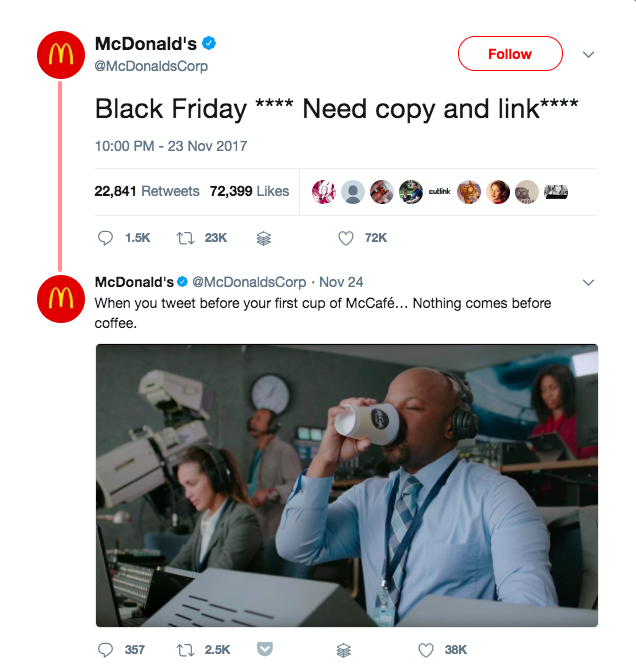
Step Two: Create Targeted Holiday Content and Promotions
November and December are arguably the best times of the year for ecommerce brands to thrive in the world of content.
Many keywords are seasonal and so if you’re able to create unique, targeted content early on in the season, then you might just see extra traffic from search. Especially if you’ve been working hard all year to create quality content that performs well on search engines!
The first things you’ll want to create are several holiday and shopping guides around very specific keywords that you’re trying to target (this also makes for great advertising content). A tool like Google Trends can help you to identify and compare keyword popularity, so you’re not guessing:[*]

If you’re a larger ecommerce business with lots of traffic, you might be able to target high-volume keywords like “women’s christmas gifts” as shown above. A “Top 50 Women’s Christmas Gifts Guide” would be the perfect complement to the above keyword.
But if you’re a small business, you’ll want to target long-tail keywords very specific to your product, geolocation, demographics, and/or niche:

Narrowing down on specific terms like “women’s boots” or “best boots for women” will help your content succeed in a very crowded space. You can then create a piece of content such “100 Women’s Boots That You Don’t Want to Miss This Holiday Season.”
Be sure to feature that awesome content prominently on your site for your customers to find:

You can use the same technique for creating promotion ideas as well. Use Google Trends to discover top keyword searches and use those to help create social media and email campaigns that people actually care about.
Use a simple Google Excel spreadsheet to track each keyword used. Track social shares, email opens and CTRs, and overall traffic. That way you can get a quick, bird’s-eye view of your top performing content across channels throughout the year.
Step Three: Prep for an Influx of Customers
If you’ve followed all of our marketing tips and strategies to this point, you will have more customers than you’ve ever had before this holiday season. Which means you, your team, and your website need to be ready.
1. Hire extra or reassign customer service staff
Handling inventory, answering customer questions, shipping, processing orders and returns all take time. And guess whose time is more important than yours during the holidays?
Your customers’ time.
Calculate what you might expect to sell this year (based on previous years and/or growth trajectory) and make an educated guess on how many people it’ll take to make sure your customers have a smooth process from start to finish with your product.

Even a simple bar chart (as shown above) mapping your sales over the last year will be helpful in knowing what to expect this year.
You can even reassign developers and designers and put them on the phone lines to answer calls from people confused about the website or their purchases.
There’s a reason that people go back to Amazon time and time again. They provide their customers with a hassle-free and speedy experience.
2. Ensure you have extra bandwidth for traffic spikes
Fast. Secure. Mobile friendly.
Those are the three critical things that people have come to expect from websites.
Check the past analytics on your website for seasonal spikes in traffic. I.e., filter by the previous year in Google Analytics and see if there were any big spikes during particular days/weeks throughout the holiday season.
Be sure that you have the bandwidth to handle this extra traffic and that your site performs well under the extra pressure.
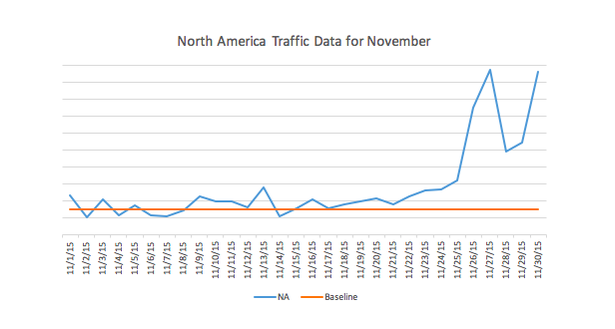
Check out these numbers from a small ecommerce business in North America. November, particularly during Black Friday and Cyber Monday, can put a major strain on your systems.
If your website is slow, crashes or causes your visitors frustration, you will lose customers (and potential returning customers). I recommend keeping your average page loading time under three seconds –– two, if possible.
August: Optimize Your Product Landing Pages For Conversion Using This Scientific, Data-Backed Method
At this point in your ecommerce marketing plan journey, you’re driving hundreds, no, thousands of visitors to your website each month. Nice work!
Now it’s time to convert all of those leads into brand new customers and revenue.
Product landing pages are one of my favorite ecommerce marketing tactics to talk about because there is a very scientific approach to creating a landing page that converts at a high rate.
Here’s how:
Step One: Understand High-Level Components of a Great Offer
The number one thing people care about when arriving at your landing page (it’s why they’re there!) is your offer.
You’ll convert customers like a champion with a solid offer that people can’t refuse. You might even convert alongside some of Sumo’s Welcome Mat top performers:
For starters, these are the most persuasive words in the English language:
- You
- Free
- Because
- Instantly
- New
Notice how these words are focused on the customer, the customer’s needs, and value. There’s no mention of “me”, “us”, or “we”, here.
Put yourself in your visitors’ shoes. If you were in their position, on this specific landing page, would you convert into a customer?
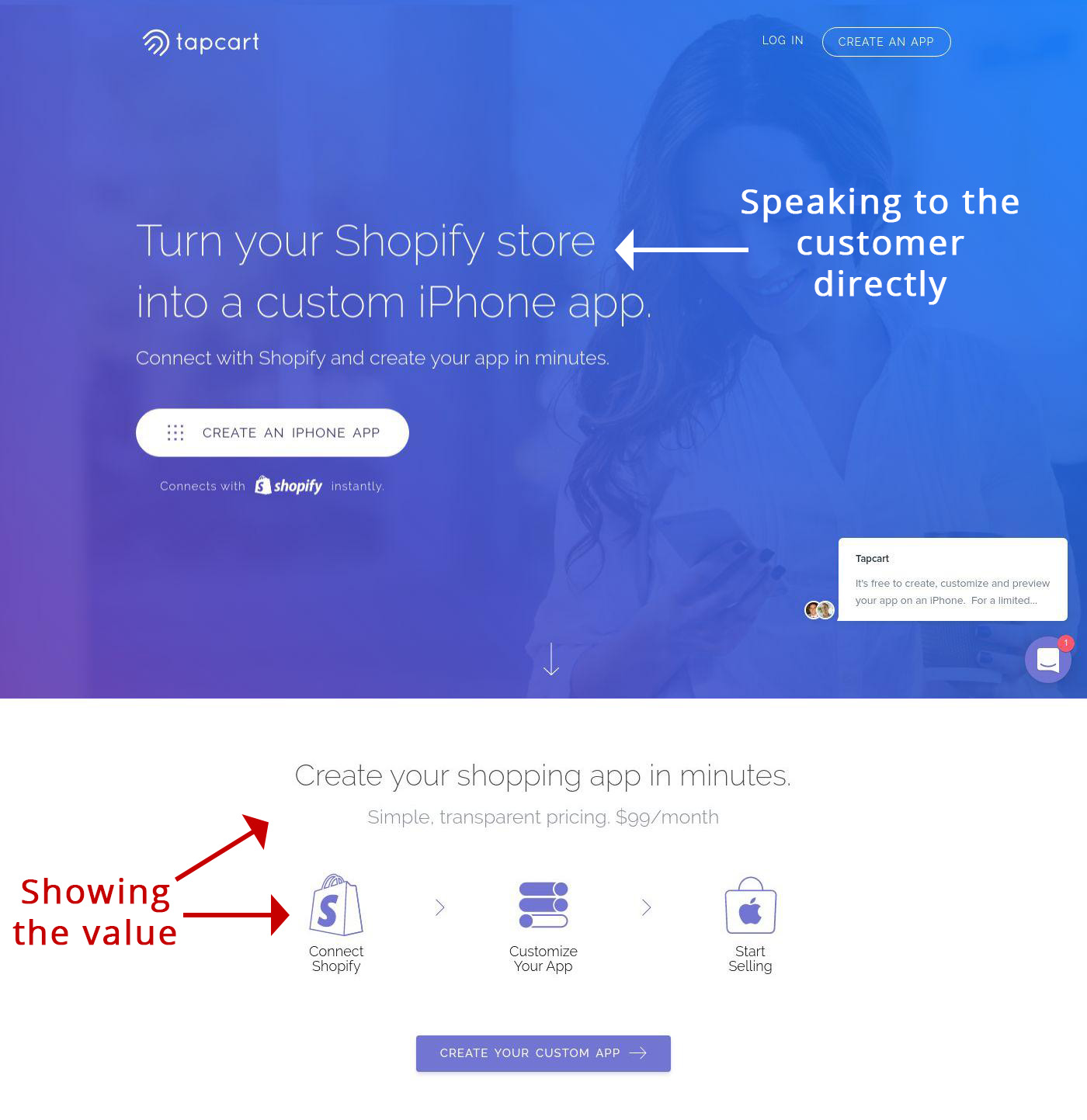
Be honest!
If you wouldn’t convert on your own landing page, your customers won’t either.
Ideas for landing page offers:
- Free consulting
- Free resources
- Discounts (see how Hemper makes thousands of sales per month with one “discount code popup”)
- Promotions
- Coupons
- Upgrades
Step Two: Craft the Perfect Headline and Copy
A big part of putting together the ultimate product landing page is the words you use to describe it.
Put simply, the headlines and copy on your landing page communicate to the visitor exactly how they will benefit from your product in a clear and concise way.
Easy, right?
Statistically speaking, 80% of your visitors will read the headline, and 20% read the actual content. You have to be strategic to overcome those odds.[*]
You can do this in lots of different ways, but one of my favorites is taking your visitors through a visual journey by using a hierarchy technique:
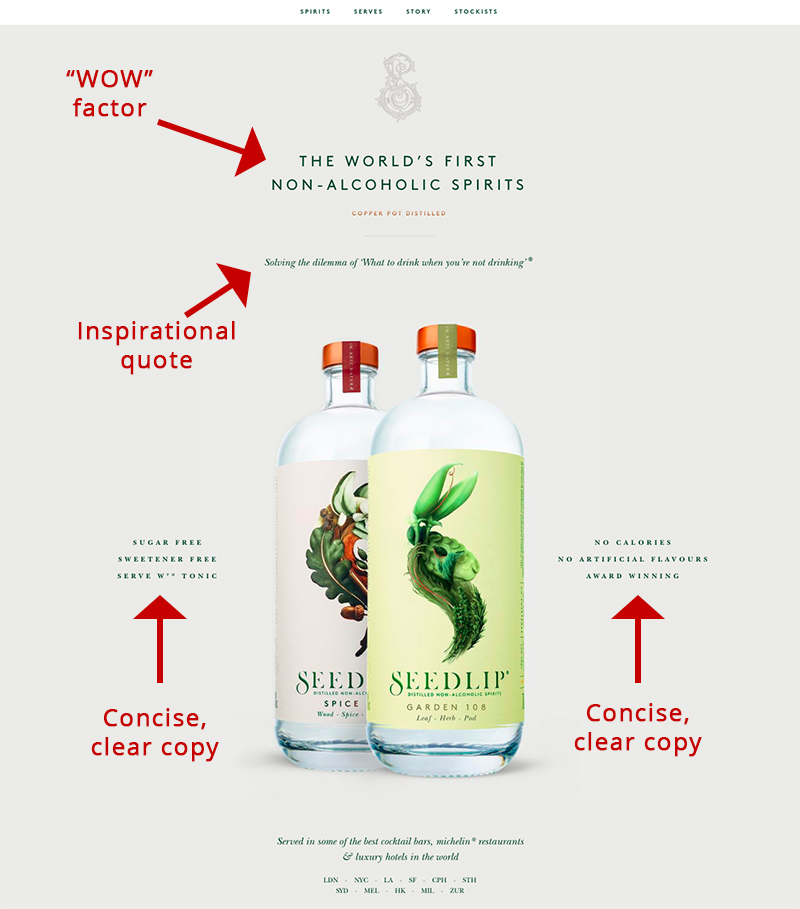
- Start with your most compelling one-liner. State the one reason that people would buy your product. What makes it great? What makes it unique? The “WOW” factor.
- Now that people are hooked, make sure they keep reading. You can do this through a “hook” statement. In the case above, it’s an inspirational quote for those who like to drink: “Solving the dilemma of ‘What to drink when you’re not drinking’”
- After people are hooked, it’s value, value, value. State everything people are going to benefit from by purchasing your product (i.e. why their lives will improve)
I’d highly recommend experimenting with your headline format, length, and wording as well. For example, studies have shown that headlines with a number can lead to a 30% higher conversion rate.[*]
P.S. Still stuck on crafting the perfect headline? Try Sumo’s automatic kickass headline generator
Step Three: Feature Amazing Product Images
As equally important as your offer, your headlines, and your copy on your product landing pages are your product photos. This goes without saying, but they should be:
- High-quality
- Dynamic (detailed, 360 views)
- Clear
- Focused
- Enticing
- Eye-catching
- Optimized for the web (compress images with a tool before uploading)
If you don’t have the gear or expertise to take beautiful product photos, I suggest you hire a professional to help. Since visitors can’t touch or hold your products in their hands, your product photos can ultimately make or break the sale.
One of my favorite examples of a product page done well is from a company called BustedTees. First, their product pages are clean, concise, and include high-quality photos of their products:
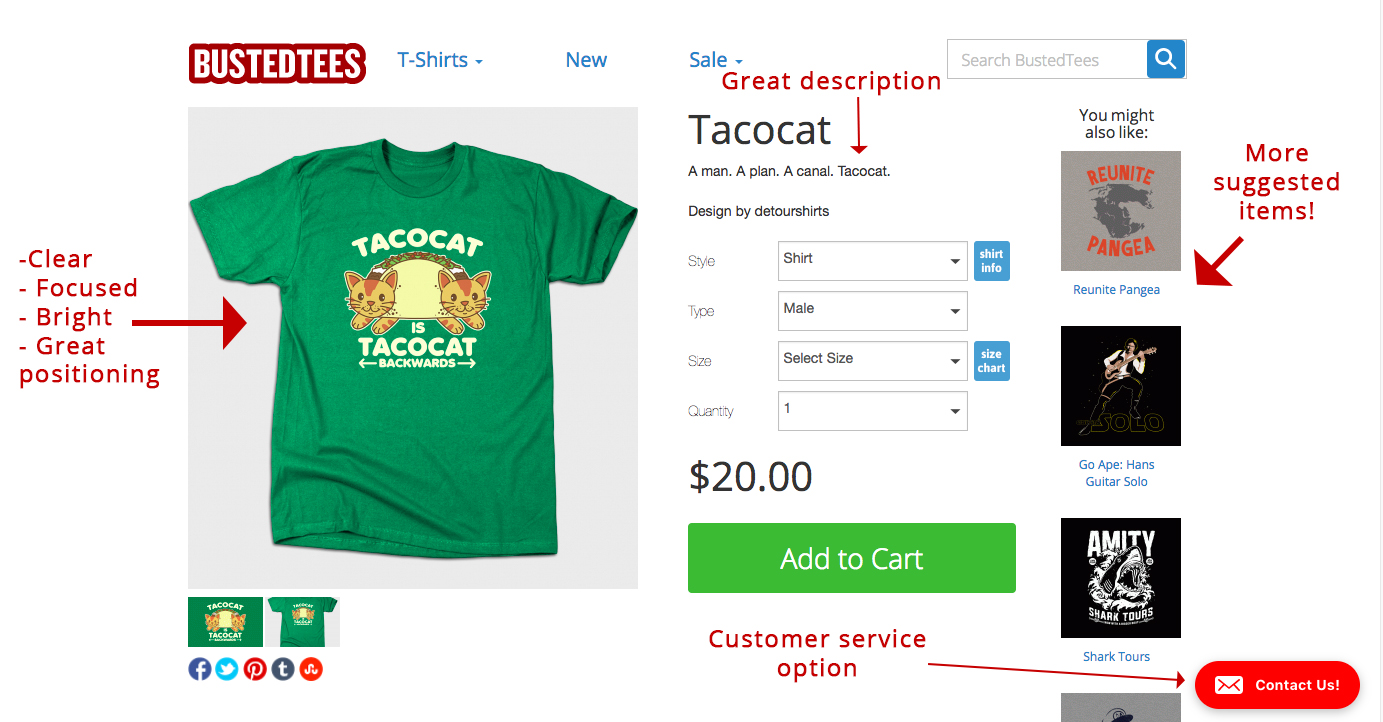
But what’s awesome, is they take it a step further. We all know how frustrating it can be to shop for clothes online. They never seem to fit! BustedTees recognized that problem and created a custom sizing chart for their visitors about to purchase:
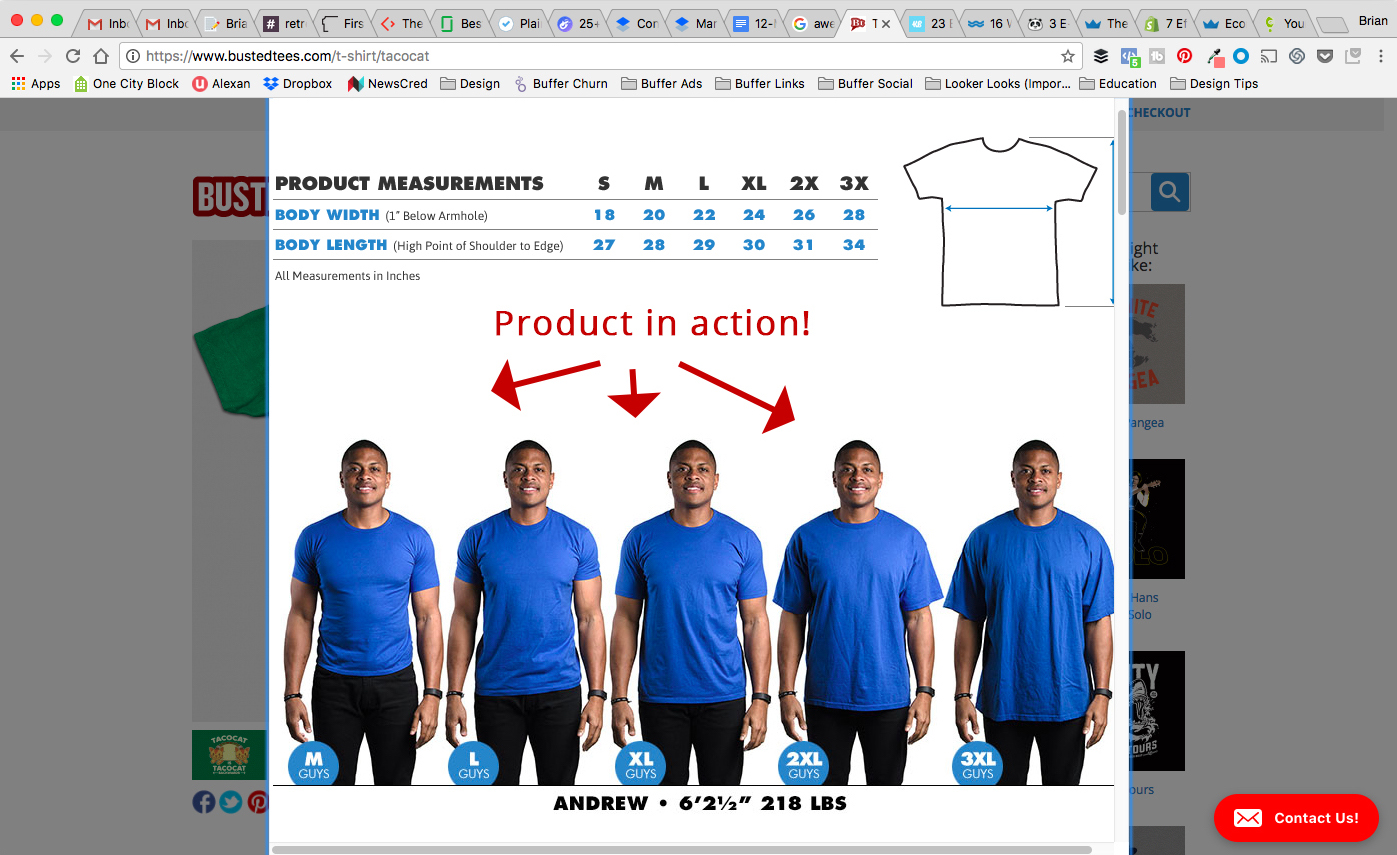
It’s a subtle landing page feature, but gives the visitor a chance to “see the product in action” before ever trying it on themselves.
P.S. If you’re unsure how or where to get started with building a landing page from scratch, I’d highly recommend checking out Sumo’s Welcome Mat.
September: Collaborate With The Most Powerful Personalities In Your Industry And Increase Referrals With Affiliate Marketing
Where influencer marketing is a marketing technique that focuses on peer-to-peer relationship building and curating content, affiliate marketing is more of a sustained business model where referral marketing is the main approach to increasing referrals (and eventually revenue).
In other words, affiliate marketing is focused on a publisher (who produces content) and a retailer (you!) who has an official affiliate program in place. Publishers are given unique retailer product links to add to their website (more on that later) and rewarded, usually monetarily, for every referral sale made.
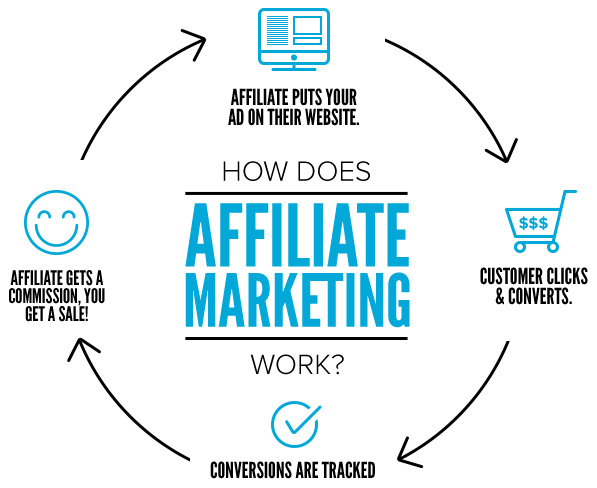
Sounds awesome, right?
Here’s how to get started with affiliate marketing today in two quick steps.
Step One: Find a Lucrative Affiliate Network
The easiest, most straightforward way to get started is to join an established affiliate network. The benefits of going this route (rather than building your own program from scratch) is that you’ll gain access to thousands of successful affiliates as well as a platform to keep track of all of your data.
One of the most well-known affiliate networks out there is CJ Affiliate — recently voted as industry network of the year.[*]

Keep in mind that with becoming a part of an affiliate network often comes an additional fee on top of what you’re paying the affiliate. Which leads perfectly into number two.
Step Two: Determine How Much You Can Afford
Obviously, high-performing and valuable affiliates are going to go with the top-paying retailers. You’ll want to decide early on how much you can afford to pay affiliates. Are you able to remain profitable on each product while also paying a commission?
Many top retailers pay anywhere between 5-20% of each product’s sale price. If you’re an early-stage ecommerce business, you might even want to consider going higher than that to compete with bigger brands.
Though it might seem costly at first look, there’s a reason why ecommerce businesses are spending more than ever before on affiliate marketing… it works.

The better the affiliate and the more referrals they send you, the more they will expect in return. Invest in the program and your affiliates could become lifelong partners of your business, bringing in hundreds of customers along the way.
October: Use Data, Intuition, And Research To Launch A Lucrative PPC Advertising Campaign
PPC advertising is a great way to drive additional revenue during the peak holiday season and continuously throughout the year.
There are two major platforms for ecommerce PPC advertising that can’t be ignored: Amazon and Google.
PLAs accounted for more than half (51%) of retail search ad clicks in Q1, up from 48% in Q4.[*]
Meanwhile, approximately 9 of 10 customers will check Amazon even if they find a product they want on another retailer’s site. Of that 9 in 10, 78% said they do this often or always.[*]

Here’s a quick overview of how to succeed with each.
Overview: Amazon Product Ads vs. Google AdWords (Key Difference)
Google AdWords (Incl. Product Listing Ads): Advertisers on Google might be aiming to aid a user’s search for information or knowledge, sign up for a program, or buy a product. There are a lot of ways to reach new customers through these five types of ads on Google which make it a dynamic platform.
- Paid Search Ads
- Shopping Ads
- Display Network Ads
- Gmail Ads
- YouTube Ads
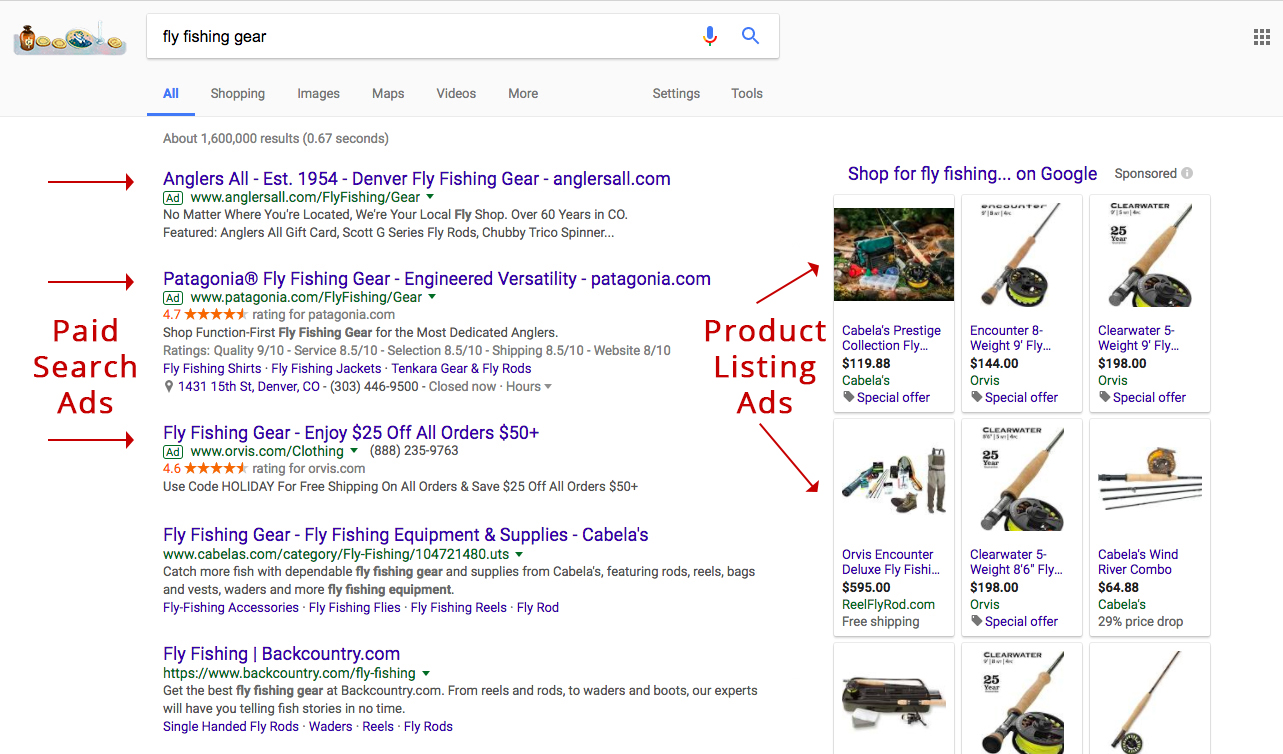
Amazon Product Ads: All ads on Amazon are focused on having the customer click on an ad placement, then click the “add to cart” button. In other words, users come to Amazon to search for products to buy, rather than to gather information.

No matter which platform you ultimately decide to use, these are key components to running a successful PPC advertising campaign:
- Reviews of your product
When you’re buying a new product, what’s the first thing you do? I’m willing to go out on a limb and bet that you look at customer reviews. It’s only human nature!
According to Pew Research, nearly 82% of American adults say they actually read reviews before they purchase something for the first time. And a majority of them compare both the negative and positive reviews.[*]
Which product would you click on first? One, two, or three?

Many ecommerce businesses would have tons of great reviews on their products if they would just ask their customers. The absolute best time to do that is directly after someone has had a good experience with your company.
Provide your happy customers with direct links to places like Google and Amazon and let them know how important their opinion is to your product and community.
But beware of restrictions that might be placed on asking your customers for reviews. Yelp, for example, is cracking down on “spam” reviews from customers and bots in an attempt to keep all reviews legitimate.
- Targeting long-tail, valuable keywords
Targeting high-volume, popular keywords in your industry may seem tantalizing. Who wouldn't want to target a keyword that brings in more than 10,000 or more searches per month?
You and everyone else. When targeting the most popular keywords in your industry, you’re competing with big brands with big PPC budgets.

You have to get crafty and targeting long-tail keywords is how you do that. Long-tail keywords will provide you with visitors that have a very specific product in mind and who are much closer to the purchase, not research phase.
My favorite (free) way to generate long-tail keywords is to go to Google and start typing a term that is related to the market that I’m researching.

Like magic, Google will start suggesting the most popular search terms. You should absolutely consider targeting these because it is likely that Google users will use them to search for your product or service.
- Pricing your ads competitively and intelligently
The truth is, many ecommerce businesses will not be able to compete with big retailers when it comes to PPC. WordStream recently found that the average CPC for ecommerce businesses is $0.88.[*]
That means you have to shell out nearly one dollar just for someone to visit your website, let alone make a purchase.

The good news is, $0.88 might be worth it if you understand what happens to your visitors after clicking on your Google or Amazon ads.
Here’s what I mean.
Let’s say you’re driving traffic to a product that sells for $40 on a landing page that converts 2% of visitors to customers.
If you spend $0.88 per click to drive 1,000 visitors ($880 spend), that means you will generate $800 in revenue from that campaign. At first, it doesn’t seem profitable.
- 1,000 visitors x $0.88 CPC = $880 ad spend
- 1,000 visitors x .02% conversation rate = 20 customers
- 20 customers x $40 product price = $800 revenue
- $800 revenue – $880 ad spend = -$40 ROI
But a deeper look may show that those customers ended up making repeat purchases or referring your product to their friends and family generating $2,000 in additional revenue per year.
Setting up proper tracking using Google UTM tracking links is critical in understanding the full impact of your PPC campaigns.
November: Growth Hack Your Website For Optimal Sales Using Tactics Implemented By The World’s Largest Businesses
There are ecommerce websites that function, and then there are ecommerce websites that turn casual shoppers into customers. It’s time to turn yours into the latter.
After analyzing more than $13 billion in ecommerce transactions, Compass found that the average bounce rate in ecommerce is 60%. If you’re operating at a 36% bounce rate or lower, you’re among the industry top performers.[*]
Here’s how to growth hack your website to lower bounce rates and convert more customers in the process.
Step One: Make Your Website Easy to Use
Customers want a smooth shopping experience from the moment they arrive to the moment they click “purchase.”
Your website navigation is the single most important factor in a customer’s experience. Simplicity and ease of use should be the goal here.
In fact, one study of 174 online customers found that 76% of them said the most important characteristic of a website is ease of use.[*]
Patagonia does a great job with not overwhelming their customers when they first arrive, only giving them a few options in the navigation bar:

Then, when you click on “Shop” they list all of their products in easy to read categories, sorted by their most popular products:

If you’re a luxury brand, you may want to model what Supreme does on their homepage.
Step Two: Offer a Powerful Search Function
Offering your customers a powerful search function is important for two reasons. One, it makes using your website easier, and two, it allows you to collect important data from your customers like popular products and specific search terms.
It’s easy to implement and a powerful functionality for your site and visitors:

Your search functionality should be included on all pages of your website. That way if a visitor gets lost or confused at any point, they can quickly search for what they were looking for.
Step Three: Include User Reviews
We’ve mentioned reviews already on Amazon, but it’s worth repeating here so you can see how to best use reviews on your own website.
Nearly 82% of American adults say they actually read reviews before they purchase something for the first time.
Make sure your reviews are:
- Included on every single item (if possible)
- Sortable by top rated
- Authentic (bad reviews aren’t a bad thing)
- Recent
- Consistent
- Front and center

We’d all love to have five-star reviews across the board on each product. But having bad reviews can actually be a good thing for your business.
Why?
It gives you the opportunity to publicly respond to the customer and make things right. It also makes your product seem “real” — customers are smart and have a keen eye for fake reviews on products.
Step Four: Suggest Related and Popular Items
One of my all-time favorite features of Amazon (and part of the reason why I think they’ve been so successful) is their remarkable “Suggested Items” feature. We can all learn a thing or two from the $136+ billion company.
My worst nightmare as a shopper is making the wrong decision. Even after all the reviews and research, I still have a fear that I’m not buying the right item.
Your customers feel this way, too. Suggesting “related” and “popular” items in real-time can help to alleviate some of those concerns.
The other day I was shopping for a new comforter:

I had no idea if I was even on the right track…
Then Amazon came to the rescue:

I was quickly able to see which items were popular based on the item I was currently looking at. And best of all, they also suggested items based on “Customers who bought this item also bought.”
Suggested items and an upsell at the same time? Well done!
December: Boost Your Email List Subscribers And Social Following By Over 400% With Viral Contests
Everyone loves free stuff.
Viral contests are a great way to attract attention to your business, grow your email list, increase traffic, and drive additional revenue.
Don’t believe me?
Unbounce compared landing pages using contests to those that didn’t… Get this, landing pages with contests captured 700% more email subscribers.[*]

Here are two types of viral contests you can run today:
Contest #1: The Social Media ‘Share-to-Win’ (Social)
If you want your contest to truly go viral, then social media will have to play a big role in increasing word-of-mouth among participants.
The best way to do this is to run a contest where social media sharing is required for entry.
Choose a platform (such as Instagram) and post the contest to your followers. Give them specific rules for entry — making sure that “tagging a friend” or “sharing on social” is required:

Then, create a landing page for your contest that details exactly how people can enter with a specific URL for each contests terms:

Bonus: Include CTAs on the landing pages to capture new visitor information.
This viral contest strategy has helped many businesses increase their Instagram following by over 400%.[*]
Contest #2: The ‘Partner’ Collaboration (Email)
If you’re a relatively small ecommerce business finding it a challenge to gain traction, then you should be partnering with other brands to help boost your email subscribers.
Find a partner within your industry, one where the relationship will be mutually beneficial, and run a viral contest over the course of a month to capture emails.
Each partner should be willing to promote the contest throughout the month to their audience and customers. There should also be an agreement on the outcome of the promotion, such as each partner will split email leads.
Back to Birchbox, here’s a great example of a partnership they ran with BuzzFeed:

“12 Days of Prizes and Surprises” from Dec 1 to Dec 12 drove hundreds of new email signups per day:
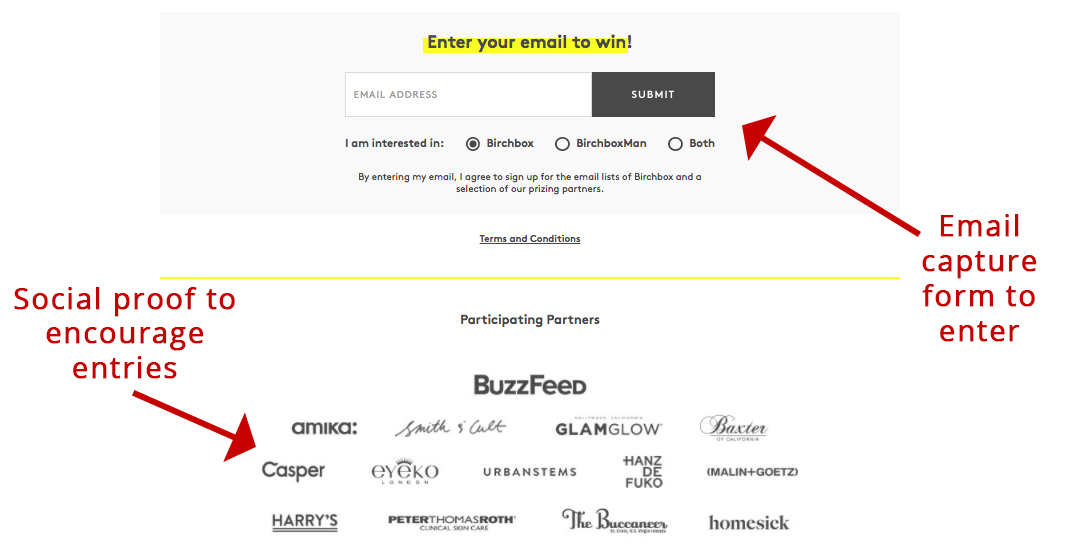
The contest does a great job of providing value to their audience by making it simple to sign up all while driving thousands of new email subscribers to Birchbox, BuzzFeed, and their participating partners.
Follow This 12-Month Ecommerce Marketing Plan Step By Step To Find Success
There you have it.
A massive, 12-month ecommerce marketing plan to help you take your business to the next level.
Every one of the steps outlined in this guide are proven methods of increasing traffic, customers, and revenue.
Skip around the guide, go back and repeat strategies, or try everything in one month. Whatever it is, make sure you give your marketing plan a facelift.
Ecommerce sales are projected to skyrocket this year, and I wouldn’t want you to miss out on any of the fun (or profits).
Related Articles
%(relatedarticles)
Add A Comment
VIEW THE COMMENTS